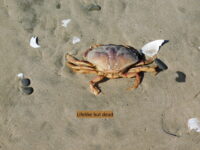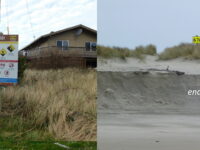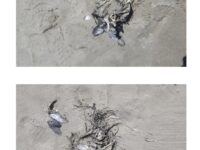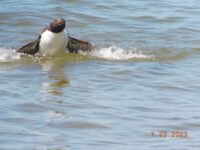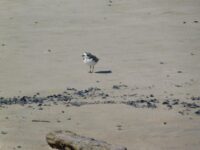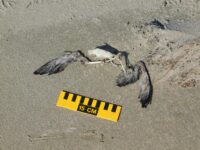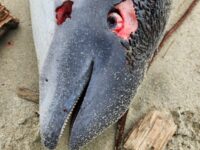Mile 202 Report
North Spit Alsea River
February 15, 2023
Today's walk included my first COASST (Coastal Observation And Seabird Survey Team) survey for beached birds.
Report Details
Today's walk included my first COASST (Coastal Observation And Seabird Survey Team) survey for beached birds. I had taken the online training class, received a kit with supplies, data sheets, and a field guide for identifying dead birds, and today I received field training from the experienced COASST volunteer who accompanied me. We only found one beached bird, mostly buried in the sand and which took a good deal of shaking and brushing off before we could measure, photograph, and try to identify it--a dark, non-descript bird with no clearly identifying features. After going through the field guide key, and more ID work back home, we tentatively agreed it was an immature Western Gull, which I'll report to COASST on my data sheet and with photos. Beached birding is somewhat physically demanding (a lot of kneeling in the sand), very detail oriented, and not for the squeamish, but especially now with avian flu present among wild birds on the Oregon coast (including a Snowy Plover on this very beach in November), it's important in helping to identify mortality events that exceed base line mortality rates and the normal deaths during winter, the breeding season, and migration. Plus it's strangely kind of fun, and a way to say R.I.P., another good reason to get out and enjoy the beach.
Conditions
Temperature: 50 F. Tide Level: 1.8 feet.
Human Activities
Number of people: 6. Number of dogs: 3. Walking or running: 6.
Vehicles
Notable Wildlife
I encountered a dozen or so Snowy Plovers, spread out a bit more than earlier in the winter and perhaps starting to pair up for nesting.
Beached Birds
Total dead birds: 1. Tentatively identified as a large immature Western Gull and reported to COASST as my first beached bird as a COASST volunteer.
Dead Fish or Invertebrates
I encountered a stiff ball, almost a foot in diameter, of what appeared to be tiny eggs of some sort, being pecked at in the wet sand by gulls. This was later identified through Monterey Bay Aquarium photos as what I believe was a ball of Lingcod eggs, the female producing between 60,000 to 500,000 eggs in an egg mass weighing up to 15 pounds and up to 2.5 feet across. This one was smaller, but I believe of the same origin.
Driftline Content
There was hardly any driftline.









Report Images
All Mile 202 Reports
Mile 202
North Spit Alsea River
Mile 202 beach accesses and exits are now restricted because of erosion and sheering off of the sand cliffs along its northern portion, so I now need to plan for a receding tide if I want to walk the entire mile safely.
Jon French
Mile 202
North Spit Alsea River
After finding forty beached Cassin's Auklets on Jan.
Jon French
Mile 202
North Spit Alsea River
A beautifully calm, sunny day, maybe the last for awhile, with a fifteen mile view from Seal Rock to Cape Perpetua and hardly anyone on the beach except for two surf fishers and a couple valiantly trying to launch a kite with no wind.
Jon French
Mile 202
North Spit Alsea River
As I began yesterday's mile walk and monthly COASST beached bird survey, a light rain began to fall, the first in months.
Jon French
Mile 202
North Spit Alsea River
As I have done before, I combined today's walk with my monthly COASST survey for dead seabirds.
Jon French
Mile 202
North Spit Alsea River
The beach was fairly cool today after 99 degrees two days ago.
Jon French
Mile 202
North Spit Alsea River
This was my second monthly beached bird survey for COASST (Coastal Observation And Seabird Survey Team) which I combined with my mile walk.
Jon French
Mile 202
North Spit Alsea River
A dead certacean was reported to the Oregon Marine Mammal Stranding Network to be on the beach in Bayshore Oregon by Beach Entrance 67d.
JLcoasties

